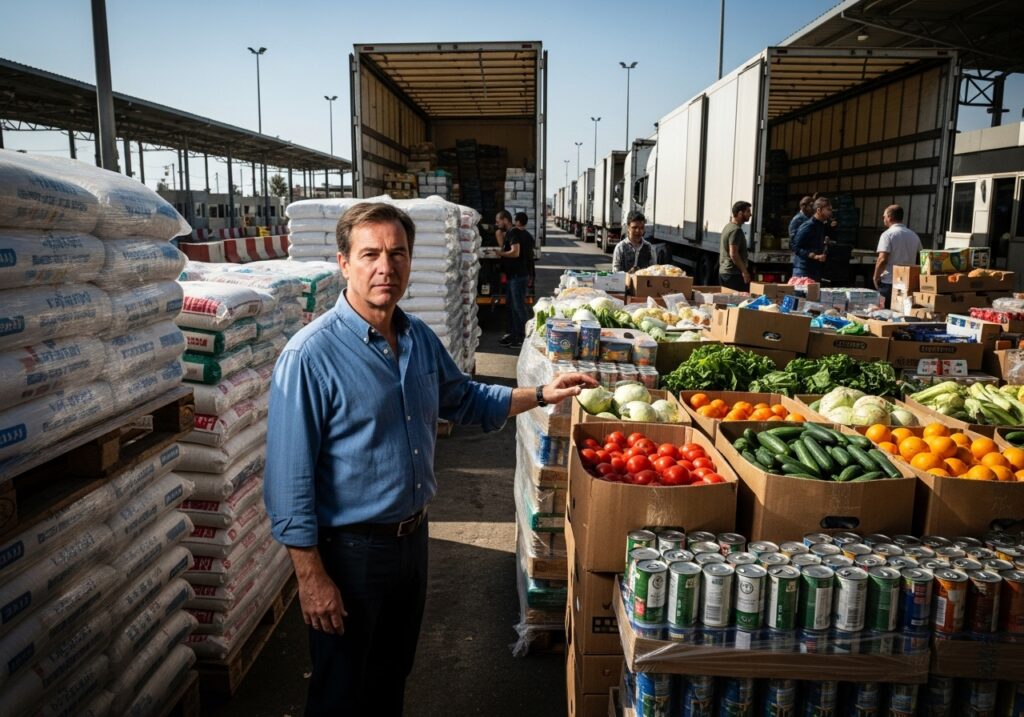The headlines have been loud and emotional: “Gaza is starving,” “Famine in Gaza,” “Children dying from hunger.” These claims have been repeated by major news outlets, celebrities, and even government officials. But a recent visit to the Israeli-Gaza border by Richard Tice, the Deputy Leader of the United Kingdom’s Reform Party, is challenging that entire story.
Tice went to the Kerem Shalom crossing, one of the main routes where humanitarian aid enters Gaza. What he saw there did not match the headlines. He described seeing stacks of fresh fruits like avocados and bananas, piles of onions, and huge amounts of flour, sugar, and canned food waiting to be delivered. This wasn’t secondhand information. Tice stood there himself and reported what he saw: a border crossing flooded with food and supplies.
So where is the famine?
Tice says the issue is not a lack of food, but a failure to distribute it. He points the finger at organizations like the United Nations Relief and Works Agency (UNRWA), which is supposed to help Palestinians. According to Tice, these groups are either too slow or outright refusing to cooperate with the Israeli checks that make sure aid doesn’t fall into the hands of Hamas — the terrorist group that controls Gaza.
When aid groups delay or refuse to follow basic rules, aid doesn’t get to the people who need it. Worse, Hamas is known to seize supplies and sell them on the black market. That drives up prices and creates the illusion of a food shortage. In other words, the situation is being manipulated — not by a lack of food, but by bad actors who benefit from chaos.
Backing up Tice’s claim is a detailed report from the Network Contagion Research Institute (NCRI), a research group that looked into the United Nations’ famine warning. The report is damning. It says the UN used bad data, ignored better information, and exaggerated the problem.
For example, the UN used only six data points to show a famine in Gaza City, and built a model that made the problem look worse than it really was. A simpler, more accurate model showed no famine. More importantly, a later survey of 15,000 children showed malnutrition was at 13.5 percent — below the 15 percent mark needed to declare a famine. That information was available before the UN made its famine announcement, but it was left out.
Even worse, the UN left out data from Rafah, a region in southern Gaza that still had a working aid system and lower hunger levels. The UN claimed Rafah was “depopulated,” even though it had been included in earlier reports. Why leave it out? Because including it would have made the situation look better — and that didn’t fit the story they wanted to tell.
The NCRI report calls this a case of “data fraud.” Tice agrees. He says it’s not just a mistake — it’s a deliberate effort to spread a false story. And that false story does real damage. It makes people in the West angry at Israel. It gives cover to Hamas. And it takes attention away from real solutions that could help both Palestinians and Israelis.
Tice has a blunt question for British taxpayers: “Why are we still funding the UN and other organizations that fail and lie?” It’s a question Americans should be asking too.
At the end of the day, the people suffering most are the innocent Palestinians caught between a terrorist regime and corrupt aid networks, and the Israelis who live under constant threat. The truth matters. And if powerful organizations are twisting facts to push a political agenda, they need to be held accountable.
This isn’t just about food. It’s about trust, responsibility, and the lives of real people on both sides of the border.

